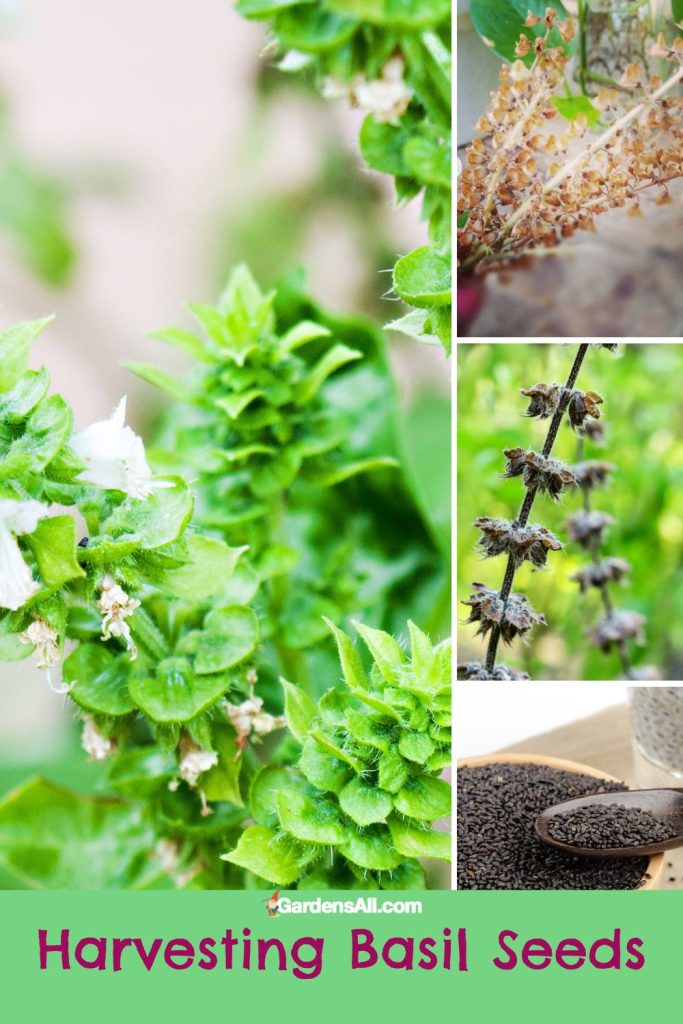Wow! We loved learning that basil seeds are used for so much more than planting new basil plants! Upon hearing that we dove into when and how to harvest basil seed so we can put them to greater use.
Basil, known by its scientific name Ocimum basilicum, is a popular culinary herb that delights with its vibrant flavor profile. While basil are well known for culinary use, especially when fresh, the basil plant also produces seeds with a range of uses.
From planting new crops to adding texture to food and drinks, these small seeds are truly multifaceted. This article aims to provide a comprehensive guide on when and how to harvest basil seeds, how to store them, and their viability duration.
If you won’t currently have basil plants (or enough basil plants for harvesting basil seeds, you can readily find them on Amazon.
HOW TO HARVEST BASIL SEEDS
When to Harvest Basil Seeds
Basil plants typically flower in mid to late summer, and seeds can be harvested when the flowers have dried out and turned brown, usually in late summer or early fall. The best time of day to harvest basil seeds is in the morning after the dew has dried.
It’s essential to allow the seeds to mature fully on the plant for them to be viable. The basil flowers will form a seed pod, and each pod contains several seeds. When the pod turns brown and brittle, it’s a good indication that the seeds are ready to be harvested.
How to Harvest Basil Seeds
Follow these steps for harvesting basil seed:
- Identify the flower spikes, or inflorescences, that have turned brown and appear dry.
- Cut the flower spikes off the plant and place them into a paper bag.
- Collect all the mature flower spikes, shake the bag gently to loosen the seeds from their pods.
- Pour the contents of the bag onto a flat, clean surface, (preferably on a dish or tea towel to keep them from rolling off and making it easier to funnel into a container).
- Separate the seeds from the chaff (the flower and pod parts). You can do this by gently blowing on the pile, as the chaff is lighter and will blow away, leaving the seeds behind.

Storing Basil Seeds
Properly stored, basil seeds are said to remain viable for planting for about five years. Here’s how to store basil seeds:
- Dry: Before storage, ensure the seeds are completely dry to prevent mold. Leave them in a dry, warm place for a few days to a week. Alternately, you can place them on a sheet in a dehydrator on the lowest setting for an hour or so. That’s especially helpful if you’re in a humid climate where things don’t dry out so well.
- Store: Once dry, store the seeds in an envelope or airtight container. Label the storage device with the date of harvest.
- Place the container in a cool, dark place. Temperature fluctuations and sunlight can damage the seeds and reduce their viability.
- Check the seeds occasionally for signs of mold or pests. Discard any seeds that show signs of damage.
Basil seeds can also be stored for culinary uses, in which case they can be kept for longer periods, although it’s best to consume them within a year for optimal flavor and texture.

How Long Do Basil Seeds Last
In optimal conditions, basil seeds can remain viable for planting for up to five years. However, as with all seeds, the germination rate tends to decrease over time, so fresher seeds generally produce better results.
For culinary uses, while basil seeds can technically be stored for several years, it’s best to consume them within a year. Beyond this point, the strength of flavor and aromatic contribution will steadily decrease over time.
You may also enjoy this article on basil seed benefits, and this one on basil microgreens.

In Summary
Harvesting, storing, and utilizing basil seeds can be a rewarding process for both gardeners and culinary enthusiasts. By understanding and working with the lifecycle of the basil plant, you will be better equipped to ensure a steady supply of this delightful herb in your garden, and as a unique and nutritious addition to meals.
Whether you’re interested in propagation or culinary use, basil seeds hold impressive potential that’s well worth exploring. We’d love to hear of your experience in harvesting and using basil seeds❣️
You may also enjoy this article on lemon balm uses, and when and how to harvest lemon balm.

I’m LeAura Alderson, a garden, herb and plant enthusiast with a passion for discovering the many edible and medicinal benefits of the plants all around us, including the weeds! I’m a writer, editor and media publisher for our family of websites.
While I was certified in fitness and life coaching, I am NOT a health practitioner. However, I’m a lifelong health enthusiast, with a keen interest in healthy, organic foods and making home remedies and the content we share is from our own experience and usage as well as that extracted from scientific research so that you can explore further on your own.
Always seek the advice and guidance of your health practitioners first and foremost.
As a family we’re steadily expanding our gardening, experimentation and knowledge around all things gardening, edible landscaping, fresh organic foods and self sustainability with farming in our future. I also own and manage iCreateDaily.com, a site all about transformation through creation, and the power of positivity, optimism and mindset.

